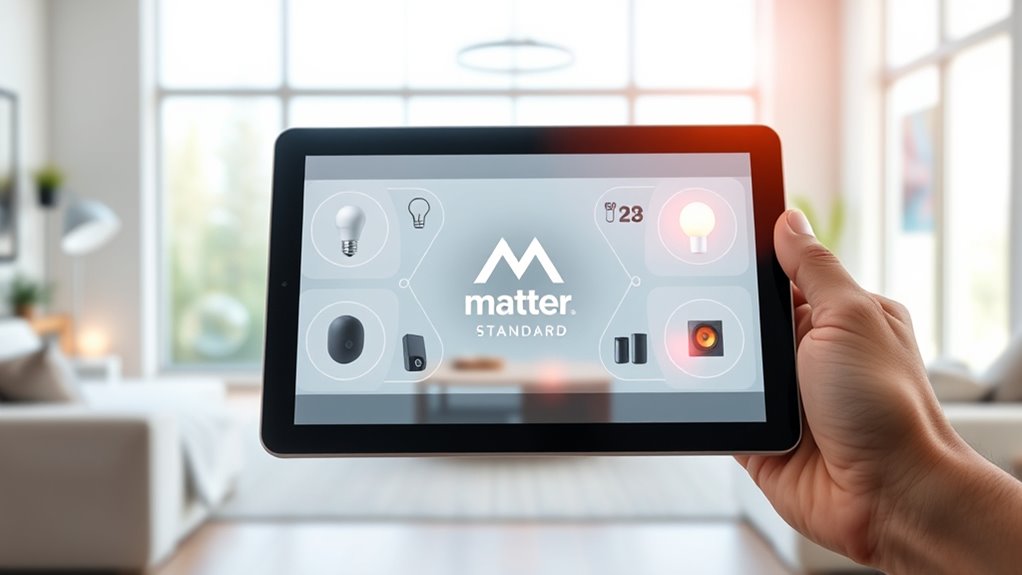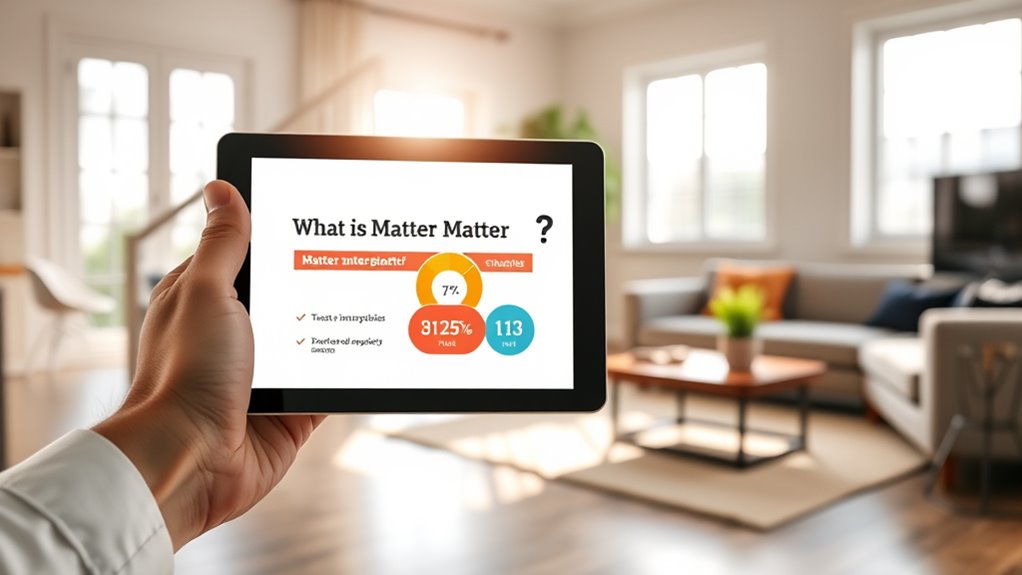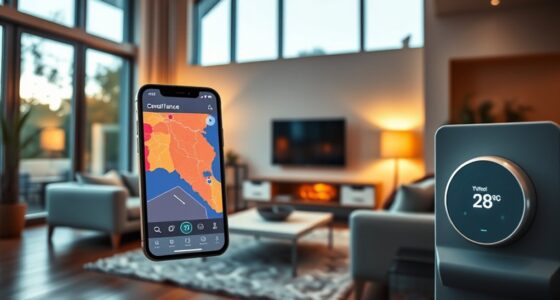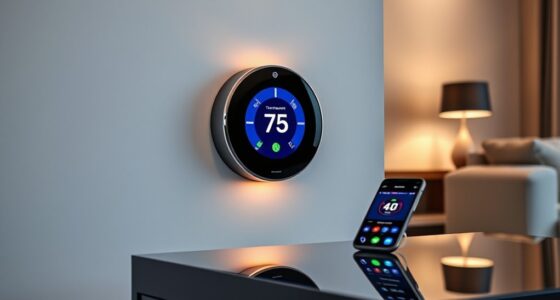The Matter standard is a unified communication protocol that makes smart home devices work together smoothly and securely, no matter the brand. It simplifies setup, improves device compatibility, and boosts security, giving you more confidence in your smart home system. By supporting interoperability and innovation, it helps your devices stay future-proof and easy to expand. Want to discover how this standard can transform your smart home experience? Keep exploring to find out more.
Key Takeaways
- The Matter Standard creates a unified communication protocol for smart home devices, ensuring seamless compatibility across brands.
- It simplifies device setup, improves security, and enhances reliability in smart home ecosystems.
- Consumers benefit from easier device integration, fewer compatibility issues, and increased confidence in smart home products.
- Manufacturers must comply with standards to meet market access requirements and ensure device interoperability.
- The standard promotes innovation and growth in the smart home industry by fostering a more connected, secure, and future-proof environment.
Understanding the Origin and Purpose of the Matter Standard

Have you ever wondered why the Matter standard was developed? As smart home technology evolved rapidly, it became clear that compatibility issues were holding back widespread adoption. The smart home evolution brought many devices from different brands, but they often couldn’t work together seamlessly. This created significant standardization challenges, frustrating users and limiting device functionality. The goal of the Matter standard is to address these issues by creating a unified protocol that ensures devices can communicate effortlessly, regardless of manufacturer. By establishing a common standard, it simplifies setup, enhances security, and promotes innovation. In essence, Matter aims to streamline your smart home experience, making it easier, more reliable, and more enjoyable to connect and control your devices. Additionally, adopting a Smart Home standard like Matter supports the growth of the smart utilities and home automation market, ensuring that your devices remain compatible as technology continues to advance. Embracing such interoperability standards is crucial for future-proofing your smart home investments.
How the Matter Standard Enhances Compatibility in Smart Devices

The Matter standard considerably improves compatibility by ensuring that smart devices from different brands can communicate seamlessly. It directly addresses interoperability challenges that have long hindered device integration, making it easier for you to set up and manage your smart home. Without the standard, incompatible protocols often mean you need multiple apps or hubs, creating frustration. By adopting a common language, Matter simplifies device pairing and reduces setup time, so you can connect new devices quickly. This uniformity means your smart home becomes more reliable and easier to expand. You won’t have to worry about whether your devices will work together; instead, they’ll share a universal language, enhancing your overall experience and confidence in your smart home ecosystem. peer-reviewed studies also support how standards like Matter foster trust and interoperability among devices, further strengthening the ecosystem’s stability.
The Benefits for Consumers and Homeowners

With the Matter standard making it easier for devices to work together, homeowners directly benefit from a more streamlined and efficient smart home experience. Improved smart home interoperability means you can control multiple devices from different brands with a single app or voice command, reducing frustration and setup time. This interoperability standard ensures that devices can communicate seamlessly, enhancing your overall smart home ecosystem. Additionally, signs of device compatibility, such as consistent communication protocols, are crucial for reliable operation. This consistency guarantees your smart devices work reliably, giving you peace of mind and saving you money by avoiding unnecessary replacements. As a consumer, you enjoy greater flexibility to choose products that fit your needs without worrying about compatibility issues. The standard also encourages competition among manufacturers, leading to better prices and innovation. Furthermore, device integration is simplified when devices adhere to the same standard, making setup and future expansion much easier. Overall, the Matter standard simplifies smart home management, making it more accessible, convenient, and enjoyable for you as a homeowner.
Implications for Manufacturers and Developers

As a manufacturer or developer, understanding regulatory compliance requirements is essential to bring your products to market smoothly. You’ll need to meet specific design and testing standards to guarantee interoperability and safety. You may also need to stay informed about ethical AI practices to ensure your products align with societal expectations and avoid potential biases. Failing to do so could hinder market access and erode consumer trust, which are indispensable for your success. Additionally, aligning your processes with regulatory standards for health and safety can help ensure your products resonate with consumer expectations and industry best practices. Being aware of compliance testing procedures can further streamline your certification process and reduce potential delays.
Regulatory Compliance Requirements
Manufacturers and developers must navigate a complex web of regulatory compliance requirements to bring matter-based products to market. These standards ensure products meet safety, security, and privacy expectations. Security concerns are at the forefront, as matter-based devices often connect to networks, creating potential vulnerabilities. You need to implement strong security measures to protect user data and prevent unauthorized access. Data privacy is equally critical; regulations may require transparent data collection practices and user consent. Failing to comply can lead to fines, recalls, or legal action, damaging your reputation. Staying ahead means understanding evolving standards and integrating compliance into your development process from the start. Additionally, being aware of personal traits and preferences can help tailor products to user needs and improve overall user satisfaction. Recognizing the importance of attention in creative practice can also enhance user engagement and experience. Understanding business hours and operations can be essential for coordinating product launches and customer support, especially when considering service availability across different regions. Ultimately, adherence to these requirements safeguards your products, users, and your business’s future.
Design and Testing Standards
Design and testing standards are critical for ensuring that matter-based products are safe, reliable, and compliant before they reach the market. These standards guide you in creating products that meet security concerns and industry expectations, fostering trust and safety. They also influence how quickly your innovations gain industry adoption, as adherence demonstrates commitment to quality. To succeed, you should focus on:
- Rigorous testing protocols to identify vulnerabilities
- Compatibility with existing security frameworks
- Clear documentation for regulatory review
- Implementing robust quality assurance measures
- Staying updated with evolving standards and best practices
- Incorporating Pimple Patch technology considerations to enhance product safety and efficacy. Additionally, understanding the Key Traits of Successful Software Quality Assurance Engineers can support your team’s efforts to maintain high standards throughout the development process. A strong emphasis on Cultural Intelligence can further improve communication across diverse teams, ensuring that standards are understood and applied consistently across global markets.
Market Access and Trust
Meeting market access requirements and building consumer trust are essential for your success in the matter-based product industry. Overcoming interoperability challenges is key to ensuring your devices work seamlessly with others, which directly impacts how easily your products can enter new markets. When your products demonstrate reliable interoperability, you boost consumer confidence, making buyers more likely to trust and adopt your solutions. Addressing these challenges early on helps you avoid delays and costly rework, streamlining certification processes. Clear communication of how your products meet standards reassures consumers and regulators alike. Additionally, implementing robust AI security measures protects sensitive data and enhances overall product trustworthiness. Recognizing the importance of standardization efforts can further facilitate smoother market entry and foster consumer confidence. Moreover, understanding the role of standards in quality assurance can help you align your products with industry benchmarks, simplifying compliance procedures. Ultimately, gaining market access hinges on your ability to deliver interoperable, trustworthy products that meet regulatory expectations and foster consumer confidence. This combination drives your growth and solidifies your reputation in the industry.
Real-World Examples of Matter in Action

Have you ever wondered how the properties of matter shape the objects and technology we rely on daily? The Matter standard guarantees devices work seamlessly together, thanks to consistent standards. For example, smart home devices from different brands can connect effortlessly, thanks to this interoperability. You might notice:
- Faster setup of connected devices
- Reliable data transfer across platforms
- Enhanced security in wireless communication
- Reduced compatibility issues
- Simplified device management
These real-world examples show how matter’s standardized approach makes your tech more efficient and user-friendly. By aligning the properties of matter with device requirements, the standard creates a cohesive ecosystem where devices communicate smoothly, ensuring your smart home, wearables, or appliances work reliably together every day. Material properties play a crucial role in enabling this interoperability, emphasizing the importance of understanding how matter works at a fundamental level. Additionally, standardized parameters help optimize device performance and longevity, making the technology more resilient and dependable. Recognizing chemical composition and other fundamental material characteristics can help improve device durability and functionality over time.
What the Future Holds for the Matter Standard

Looking ahead, the future of the Matter standard promises even greater integration and innovation in smart technology. As the interoperability evolution continues, devices from different brands will work together more seamlessly, making smart homes more user-friendly. However, standardization challenges remain, as industry players work to align their protocols and ensure consistent implementation. Overcoming these hurdles will require ongoing collaboration and updates to the standard. You can expect smarter, more reliable devices that communicate effortlessly, simplifying your daily routines. As the Matter standard matures, it will foster a more unified ecosystem, reducing frustrations and expanding possibilities. Additionally, the increasing adoption of security systems and smart home devices will drive demand for standardized solutions, ensuring compatibility across a broader range of products. The ongoing market growth in AI-driven smart home technology underscores the importance of such standards to support innovation and consumer confidence. Moreover, as consumers become more aware of the benefits of interoperability, demand for compatible devices will continue to rise, further accelerating the development of comprehensive standards. Ultimately, this evolution will empower you to enjoy a more connected, efficient, and secure smart home experience.
Frequently Asked Questions
How Does the Matter Standard Impact Privacy and Security?
The Matter standard boosts privacy and security by addressing interoperability challenges between smart devices. It requires strong data encryption, making it harder for hackers to access your info. You benefit from seamless device integration without sacrificing safety, as the standard enforces strict security protocols. This means your smart home stays private and secure, giving you peace of mind knowing your data is protected across different brands and platforms.
Can Existing Smart Devices Be Upgraded to Support Matter?
Imagine giving your smart device a fresh breath of life—yes, upgrades can do that. While not all existing devices are instantly compatible, many can be retrofitted with firmware updates that enable support for the Matter standard. Check your device’s compatibility and update options; manufacturers often release firmware updates to enhance device compatibility, making your smart home more seamless, secure, and future-ready without needing a full replacement.
What Companies Are Leading the Development of the Matter Standard?
You’ll want to know that major companies like Apple, Google, Amazon, and Samsung are leading the development of the Matter standard. They aim to overcome interoperability challenges, making it easier for your smart devices to work seamlessly together. This standard promises to enhance your user experience by simplifying setup and control, ensuring your smart home is more reliable and user-friendly. Their collaboration signals a more unified smart device ecosystem ahead.
How Does Matter Compare to Other Smart Home Standards?
They say, “A chain is only as strong as its weakest link,” and that applies here. Compared to other smart home standards, Matter offers better interoperability benefits and device compatibility, making it easier for your devices to work seamlessly together. Unlike fragmented standards, Matter simplifies setup and reduces frustrations, so your smart home becomes more reliable and user-friendly. It’s a game-changer for anyone wanting a truly connected home experience.
Will Matter Reduce the Cost of Smart Home Devices?
You’ll likely see cost savings with Matter as it boosts interoperability benefits, making it easier to connect devices from different brands. When devices work seamlessly together, you won’t need to buy multiple versions or replace incompatible gadgets. This standard streamlines smart home setups, reduces frustration, and cuts costs over time. Overall, Matter’s focus on compatibility is designed to make smart home devices more affordable and accessible for you.
Conclusion
So, now you know why the Matter standard matters—literally. It promises a future where your smart devices play nice, and you can finally stop playing device detective. But don’t get too excited; manufacturers might still find clever ways to keep you guessing. Still, if you want a home that’s smarter than your neighbor’s, it’s time to embrace Matter—because who doesn’t want their gadgets to finally get along, right?









